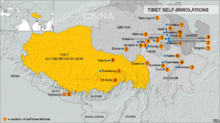


As of 11 April 2015 there have been about 138[1] reported self-immolationsinTibet since 27 February 2009, when Tapey, a young monk from Kirti Monastery, set himself on fire in the marketplace in Ngawa City, Ngawa County, Sichuan.[2] In 2011 a wave of self-immolations by Tibetans in Chinese-occupied Tibet, as well as in India and Nepal, occurred after the self-immolation of Phuntsog of 16 March 2011 in Ngawa County, Sichuan. Protests are ongoing.[3]
Most of the protesters have been monks and nuns, or ex-monks[4][5] Some of the protesters who set themselves on fire were teenagers.[6][7][8][9]
Most such incidents have taken place in China's Sichuan province, especially around the Kirti Monastery in Ngawa City, Ngawa County, Sichuan,[2] others in Gansu and Qinghai and Tibet Autonomous Region. Self-immolation protests by Tibetans also occurred in India[10] and Kathmandu, Nepal.[5]
According to Reuters the Dalai Lama, spiritual leader of Tibet, said in March 2012 he does not encourage the protests, but he has praised the courage of those who had engaged in self-immolation[11] and blamed the self-immolations on "cultural genocide" by the Chinese.[6] Four months later the Dalai Lama made clear that he wishes to remain neutral regarding this topic and he explained why to The Hindu:[12]
This is a very, very delicate political issue. Now, the reality is that if I say something positive, then the Chinese immediately blame me. If I say something negative, then the family members of those people feel very sad. They sacrificed their own life. It is not easy. So I do not want to create some kind of impression that this is wrong. So the best thing is to remain neutral.
When asked by an Australian journalist if Tibetans are "losing patience with non-violence", the Dalai Lama replied:
No. I think the self-burning itself on practice of non-violence. These people, you see, they easily use bomb explosive, more casualty people. But they didn't do that. Only sacrifice their own life. So this also is part of practice of non-violence.[13]
Wen Jiabao, premier of China, said that such extreme actions hurt social harmony and that Tibet and the Tibetan areas of Sichuan are integral parts of Chinese territory.[14] According to The Economist, the self-immolations have caused the government's attitude to harden.[5]
Stephen Prothero stated that in a very real sense, blood of the victims is on Dalai Lama's hands. [15]
Self-immolations by Tibetans protesting Chinese domination of Tibet have had a greater impact than earlier protests. Despite considerable loss of life during the Tibetan protests in 2008 on the part of both the Tibetan and Han population in Tibet, casualties were simply not reported by the Chinese government. Self-immolations, on the other hand, result in dramatic images of the protester, while burning[5] or afterwards,[16] which can be easily transmitted over the internet to news media and supporters. Internet access has reached even remote areas in the parts of China where Tibetans live.[17]
However, sensitive areas of Tibet are often subject to communication clampdowns.[18] These blackouts, along with the ban of foreign journalists and human rights monitors, means obtaining exact numbers of self immolations in Tibet is difficult. However, a number of organisations, such as Free Tibet, do keep up-to-date lists of confirmed incidents.
27.2. Ngawa1
March: Ngawa 1, August: Kardze (Dau County) 1, September: Ngawa 2, October: Ngawa 5, Kardze 1, November: Kardze (Dau County) 1, India 1, Nepal 1, December: Chamdo1
January (4): Ngawa 3, Golog 1, February (6): Ngawa 4, Yushu (Thridu County) 1, Amdo Haixi 1, March (11): Kanlho 1, Ngawa 7, Malho (Rebkong County) 2, India 1, April (4): Kardze 2, Ngawa 2, May (3): Lhasa City 2, Ngawa 1, June (4): Malho (Cantsha County) 1, Yushu (Thridu County) 2, Yushu 1, July (2): Lhasa (Damshung County) 1, Ngawa 1, August (7): Ngawa 6, Kanlho 1, September (2): Beijing 1, Yushu (Zado County) 1, October (10): Nagchu 1, Kanlho 7, Nagchu (Driru County) 2, November (28): Malho (Rebkong County) 9, Malho (Zeku County) 3, Amdo Haidong 1, Ngawa 3, Ngawa (Zoige County) 2, Kardze 1, Nagchu (Driru County) 1, Kanlho 2, Kanlho (Sangchu County) 3, Kanlho (Luchu County) 3, December (5): Kanlho (Sangchu County) 1, Kanlho (Luchu County) 1, Golog 1, Ngawa 1, Malho 1,
January (3): Kanlho (Sangchu County) 2, Ngawa 1, February (9): Ngawa 1, Kanlho (Sangchu County) 2, Nepal 1, Ngawa (Zoige County) 3, Amdo Haidong 1, Kanlho (Luchu County) 1, March (5): Ngawa (Zoige County) 1, Ngawa 2, Kanlho (Sangchu County) 1, Kanlho (Luchu County) 1, April (3): Ngawa 1, Ngawa (Zoige) 2, May (1): Yushu (Chumarleb County) 1, June (1): Kardze (Dau County) 1, July (1): Ngawa (Zoige County) 1, August (1): Nepal 1, September (1): Ngawa 1, November (1): Golog 1, December (2): Ngawa 1, Kanlho (Sangchu County) 1,
February (2): Malho 1, Ngawa 1, March (3): Malho 1, Ngawa 1, Kardze (Litang County) 1, April (1): Kardze (Dau County) 1, September: (2) Golog 1, Kanlho 1, December (3): Kanlho 1, Ngawa 1, Kardze (Dau County) 1,
March: Ngawa 1, April: Kardze 1, Ngawa 1 May: Kardze (Dau County) 1, Kanlho (Jonê County) 1
She was the second woman to set herself on fire this year and the 138th Tibetan to do so since 2009 in Tibetan regions ruled by China, according to the International Campaign for Tibet, an advocacy group based in Washington.